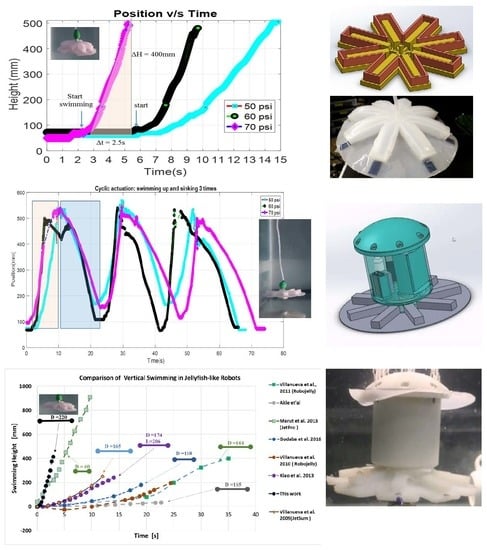FludoJelly: Experimental Study on Jellyfish-Like Soft Robot Enabled by Soft Pneumatic Composite (SPC)
Abstract
1. Introduction
2. Materials and Method
2.1. Soft Pneumatic Composite (SPC) Actuator
2.2. Biomimetic Jellyfish Design
2.3. Experimental Setup for Testing Swimming
3. Results and Discussion
3.1. Displacement Profile XY Trajectories of the SPC Actuators
3.2. Position Tracking During Swimming of the Fludojelly
3.3. Cyclic Actuation of the FludoJelly
3.4. Testing Deflection of the Bell at Different Height in A Water Column
3.5. Comparison of Fludojelly with Other Jellyfish-Like Prototypes
3.6. Peripheral Components and Future Works
4. Conclusions
Supplementary Materials
Author Contributions
Funding
Acknowledgments
Conflicts of Interest
References
- Bar-Cohen, Y. Biomimetics—using nature to inspire human innovation. Bioinspir. Biomim. 2006, 1, P1–P12. [Google Scholar] [CrossRef] [PubMed]
- Jusufi, A.; Vogt, D.M.; Wood, R.J.; Lauder, G.V. Undulatory swimming performance and body stiffness modulation in a soft robotic fish-inspired physical model. Soft Robot. 2017, 4, 1–9. [Google Scholar] [CrossRef] [PubMed]
- Kim, H.-S.; Lee, J.-Y.; Chu, W.-S.; Ahn, S.-H. Design and Fabrication of Soft Morphing Ray Propulsor: Undulator and Oscillator. Soft Robot. 2017, 4, 49–60. [Google Scholar] [CrossRef] [PubMed]
- Lin, H.-T.; Leisk, G.G.; Trimmer, B. GoQBot: A caterpillar-inspired soft-bodied rolling robot. Bioinspir. Biomim. 2011, 6, 026007. [Google Scholar] [CrossRef] [PubMed]
- Rus, D.; Tolley, M.T. Design, fabrication and control of soft robots. Nature 2015, 521, 467–475. [Google Scholar] [CrossRef] [PubMed]
- Shepherd, R.F.; Stokes, A.A.; Nunes, R.; Whitesides, G.M. Soft machines that are resistant to puncture and that self seal. Adv. Mater. 2013, 25, 6709–6713. [Google Scholar] [CrossRef] [PubMed]
- Tolley, M.T.; Shepherd, R.F.; Mosadegh, B.; Galloway, K.C.; Wehner, M.; Karpelson, M.; Wood, R.J.; Whitesides, G.M. A resilient, untethered soft robot. Soft Robot. 2014, 1, 213–223. [Google Scholar] [CrossRef]
- Mosadegh, B.; Polygerinos, P.; Keplinger, C.; Wennstedt, S.; Shepherd, R.F.; Gupta, U.; Shim, J.; Bertoldi, K.; Walsh, C.J.; Whitesides, G.M. Pneumatic networks for soft robotics that actuate rapidly. Adv. Funct. Mater. 2014, 24, 2163–2170. [Google Scholar] [CrossRef]
- Sun, Y.; Song, Y.S.; Paik, J. Characterization of silicone rubber based soft pneumatic actuators. In Proceedings of the 2013 IEEE/RSJ International Conference on Intelligent Robots and Systems, Tokyo, Japan, 3–7 November 2013; pp. 4446–4453. [Google Scholar]
- Lu, X.; Xu, W.; Li, X. Concepts and simulations of a soft robot mimicking human tongue. In Proceedings of the 2015 6th International Conference on Automation, Robotics and Applications (ICARA), Queenstown, New Zealand, 17–19 February 2015; pp. 332–336. [Google Scholar]
- Marchese, A.D.; Katzschmann, R.K.; Rus, D. A recipe for soft fluidic elastomer robots. Soft Robot. 2015, 2, 7–25. [Google Scholar] [CrossRef] [PubMed]
- Shepherd, R.F.; Ilievski, F.; Choi, W.; Morin, S.A.; Stokes, A.A.; Mazzeo, A.D.; Chen, X.; Wang, M.; Whitesides, G.M. Multigait soft robot. Proc. Natl. Acad. Sci. USA 2011, 108, 20400–20403. [Google Scholar] [CrossRef] [PubMed]
- Wehner, M.; Truby, R.L.; Fitzgerald, D.J.; Mosadegh, B.; Whitesides, G.M.; Lewis, J.; Wood, R.J. An integrated design and fabrication strategy for entirely soft, autonomous robots. Nature 2016, 536, 451–455. [Google Scholar] [CrossRef] [PubMed]
- Katzschmann, R.K.; Marchese, A.D.; Rus, D. Hydraulic autonomous soft robotic fish for 3D swimming. In Experimental Robotics; Springer: Berlin, Germany, 2016; Volume 109, pp. 405–420. [Google Scholar]
- Park, Y.-L.; Chen, B.-R.; Pérez-Arancibia, N.O.; Young, D.; Stirling, L.; Wood, R.J.; Goldfield, E.C.; Nagpal, R. Design and control of a bio-inspired soft wearable robotic device for ankle-foot rehabilitation. Bioinspir. Biomim. 2014, 9, 016007. [Google Scholar] [CrossRef] [PubMed]
- Colin, S.P.; Costello, J.H. Morphology, swimming performance and propulsive mode of six co-occurring hydromedusae. J. Exp. Biol. 2002, 205, 427–437. [Google Scholar] [PubMed]
- AquaJellies 2.0 Autonomous behaviour in a collective. 2017. Available online: https://www.festo.com/group/en/cms/10227.htm (accessed on 30 July 2017).
- Xiao, J.; Duan, J.; Yu, J. Design and implementation of a novel biomimetic robotic jellyfish. In Proceedings of the IEEE International Conference on Robotics and Biomimetics (ROBIO), Shenzhen, China, 12–14 December 2013; pp. 988–993. [Google Scholar]
- Villanueva, A.; Bresser, S.; Chung, S.; Tadesse, Y.; Priya, S. Jellyfish inspired unmanned underwater vehicle. In Electroactive Polymer Actuators and Devices (EAPAD) 2009, Proceedings of the SPIE Smart Structures and Materials + Nondestructive Evaluation and Health Monitoring, San Diego, CA, USA, 8–12 March 2009; SPIE: Bellingham, WA, USA, 2009; Volume 7287, p. 7287. [Google Scholar]
- Villanueva, A.; Smith, C.; Priya, S. A biomimetic robotic jellyfish (Robojelly) actuated by shape memory alloy composite actuators. Bioinspir. Biomim. 2011, 6, 036004. [Google Scholar] [CrossRef] [PubMed]
- Tadesse, Y.; Villanueva, A.; Haines, C.; Novitski, D.; Baughman, R.; Priya, S. Hydrogen-fuel-powered bell segments of biomimetic jellyfish. Smart Mater. Struct. 2012, 21, 045013. [Google Scholar] [CrossRef]
- Villanueva, A.A.; Marut, K.J.; Michael, T.; Priya, S. Biomimetic autonomous robot inspired by the Cyanea capillata (Cyro). Bioinspir. Biomim. 2013, 8, 046005. [Google Scholar] [CrossRef] [PubMed]
- Yang, Y.; Ye, X.; Guo, S. A new type of jellyfish-like microrobot. In Proceedings of the 2007 IEEE International Conference on Integration Technology, Shenzhen, China, 20–24 March 2007; pp. 673–678. [Google Scholar]
- Nawroth, J.C.; Lee, H.; Feinberg, A.W.; Ripplinger, C.M.; McCain, M.L.; Grosberg, A.; Dabiri, J.O.; Parker, K.K. A tissue-engineered jellyfish with biomimetic propulsion. Nat. Biotechnol. 2012, 30, 792–797. [Google Scholar] [CrossRef] [PubMed]
- Frame, J.; Lopez, N.; Curet, O.; Engeberg, E.D. Thrust force characterization of free-swimming soft robotic jellyfish. Bioinspir. Biomim. 2018, 13, 064001. [Google Scholar] [CrossRef]
- Smith, C.; Villanueva, A.; Joshi, K.; Tadesse, Y.; Priya, S. Working principle of bio-inspired shape memory alloy composite actuators. Smart Mater. Struct. 2010, 20, 012001. [Google Scholar] [CrossRef]
- Tadesse, Y.; Brennan, J.; Smith, C.; Long, T.E.; Priya, S. Synthesis and characterization of polypyrrole composite actuator for jellyfish unmanned undersea vehicle. In Electroactive Polymer Actuators and Devices (EAPAD) 2009, Proceedings of the SPIE Smart Structures and Materials + Nondestructive Evaluation and Health Monitoring, San Diego, CA, USA, 7–11 March 2010; SPIE: Bellingham, WA, USA, 2010; Volume 7642, p. 7642. [Google Scholar]
- Yeom, S.-W.; Oh, I.-K. A biomimetic jellyfish robot based on ionic polymer metal composite actuators. Smart Mater. Struct. 2009, 18, 085002. [Google Scholar] [CrossRef]
- HARLAN, R. 10 Weird Self-Inflating Animal Species. 2014. Available online: http://listverse.com/2014/01/03/10-weird-self-inflating-animal-species/ (accessed on 30 July 2017).
- Quin Marshall “Get Down In Jellytown!”. Available online: https://quinsprogress.com/2014/02/ (accessed on 5 June 2019).
- Australian Red-eyed Tree Frog (Litoria chloris). Available online: https://en.wikipedia.org/wiki/Vocal_sac#/media/File:Litoria_chloris_calling.jpg (accessed on 5 June 2019).
- Ilievski, F.; Mazzeo, A.D.; Shepherd, R.F.; Chen, X.; Whitesides, G.M. Soft robotics for chemists. Angew. Chem. 2011, 123, 1930–1935. [Google Scholar] [CrossRef]
- Almubarak, Y.; Tadesse, Y. Twisted and coiled polymer (TCP) muscles embedded in silicone elastomer for use in soft robot. Int. J. Intell. Robot. Appl. 2017, 1, 352–368. [Google Scholar] [CrossRef]
- Onal, C.D.; Chen, X.; Whitesides, G.M.; Rus, D. Soft mobile robots with on-board chemical pressure generation, In Robotics Research; Springer: Berlin, Germany, 2017; Volume 100, pp. 525–540. [Google Scholar]
- Marchese, A.D.; Onal, C.D.; Rus, D. Autonomous soft robotic fish capable of escape maneuvers using fluidic elastomer actuators. Soft Robot. 2014, 1, 75–87. [Google Scholar] [CrossRef] [PubMed]
- Marchese, A.D.; Rus, D. Design, kinematics, and control of a soft spatial fluidic elastomer manipulator. Int. J. Robot. Res. 2016, 35, 840–869. [Google Scholar] [CrossRef]
- Villanueva, A.; Vlachos, P.; Priya, S. Flexible margin kinematics and vortex formation of Aurelia aurita and Robojelly. PLoS ONE 2014, 9, e98310. [Google Scholar] [CrossRef] [PubMed]
- Douglas Brown, Tracker: Open source video analysis and modeling tool, Available online:. Available online: http://physlets.org/tracker/ (accessed on 18 February 2018).
- Giorgio-Serchi, F.; Weymouth, G.D. Underwater soft robotics, the benefit of body-shape variations in aquatic propulsion. In Soft Robotics: Trends, Applications and Challenges; Springer: Berlin, Germany, 2017; Volume 17, pp. 37–46. [Google Scholar]
- Renda, F.; Serchi, F.G.; Boyer, F.; Laschi, C. Structural dynamics of a pulsed-jet propulsion system for underwater soft robots. Int. J. Adv. Robot. Syst. 2015, 12, 68. [Google Scholar] [CrossRef]
- Giorgio-Serchi, F.; Lidtke, A.K.; Weymouth, G.D. A soft aquatic actuator for unsteady peak power amplification. IEEE/ASME Trans. Mechatron. 2018, 23, 2968–2973. [Google Scholar] [CrossRef]
- Keithly, D.; Whitehead, J.; Voinea, A.; Horna, D.; Hollenberg, S.; Peck, M.; Pikul, J.; Shepherd, R.F. A cephalopod-inspired combustion powered hydro-jet engine using soft actuators. Extreme Mech. Lett. 2018, 20, 1–8. [Google Scholar] [CrossRef]
- Salazar, R.; Fuentes, V.; Abdelkefi, A. Classification of biological and bioinspired aquatic systems: A review. Ocean Eng. 2018, 148, 75–114. [Google Scholar] [CrossRef]
- Akle, B.; Najem, J.; Leo, D.; Blottman, J. Design and development of bio-inspired underwater jellyfish like robot using ionic polymer metal composite (IPMC) actuators. In Electroactive Polymer Actuators and Devices (EAPAD) 2011, Proceedings of the SPIE Smart Structures and Materials + Nondestructive Evaluation and Health Monitoring, San Diego, CA, USA, 6–10 March, 2011; SPIE: Bellingham, WA, USA, 2011; Volume 7976, p. 7976. [Google Scholar]
- Godaba, H.; Li, J.; Wang, Y.; Zhu, J. A soft jellyfish robot driven by a dielectric elastomer actuator. In IEEE Robot. Auto. Lett. 2016, 1, 624–631. [Google Scholar] [CrossRef]
- Marut, K.; Stewart, C.; Michael, T.; Villanueva, A.; Priya, S. A jellyfish-inspired jet propulsion robot actuated by an iris mechanism. Smart Mater. Struct. 2013, 22, 094021. [Google Scholar] [CrossRef]
- Gemmell, B.J.; Costello, J.H.; Colin, S.P.; Stewart, C.J.; Dabiri, J.O.; Tafti, D.; Priya, S. Passive energy recapture in jellyfish contributes to propulsive advantage over other metazoans. Proc. Natl. Acad. Sci. USA 2013, 110, 17904–17909. [Google Scholar] [CrossRef] [PubMed]
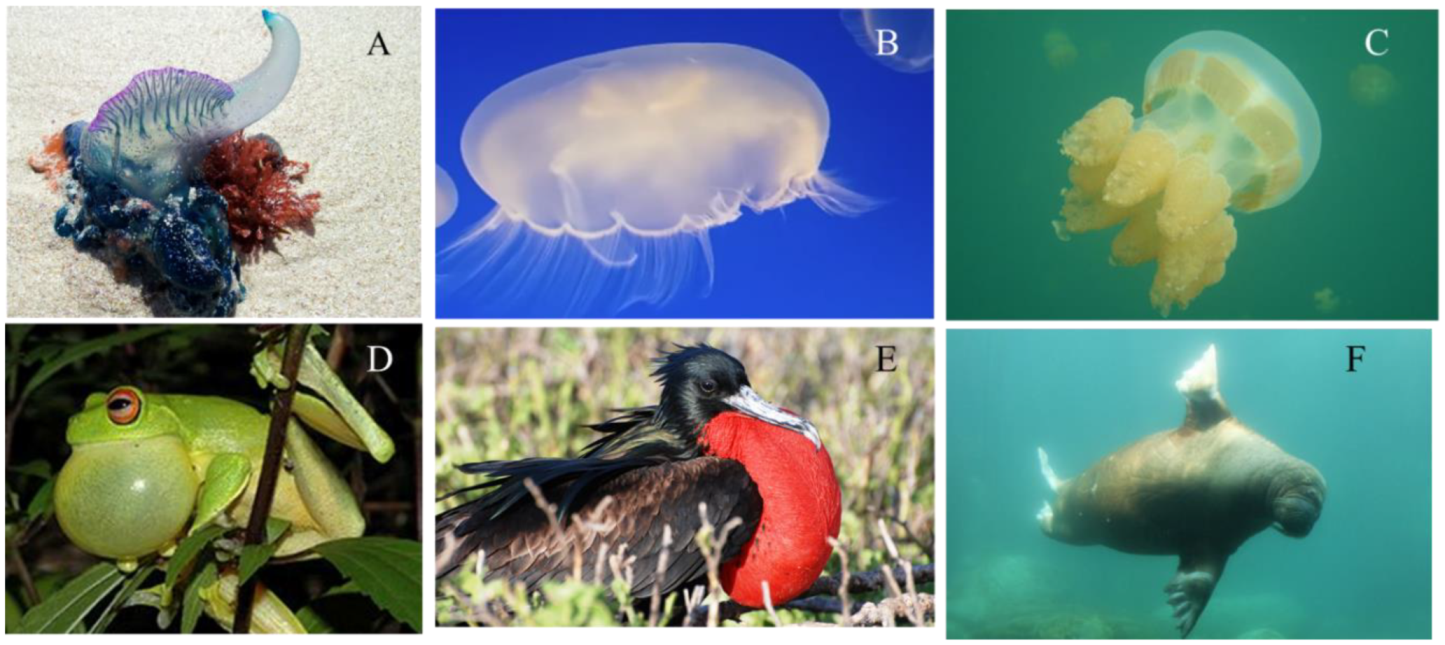
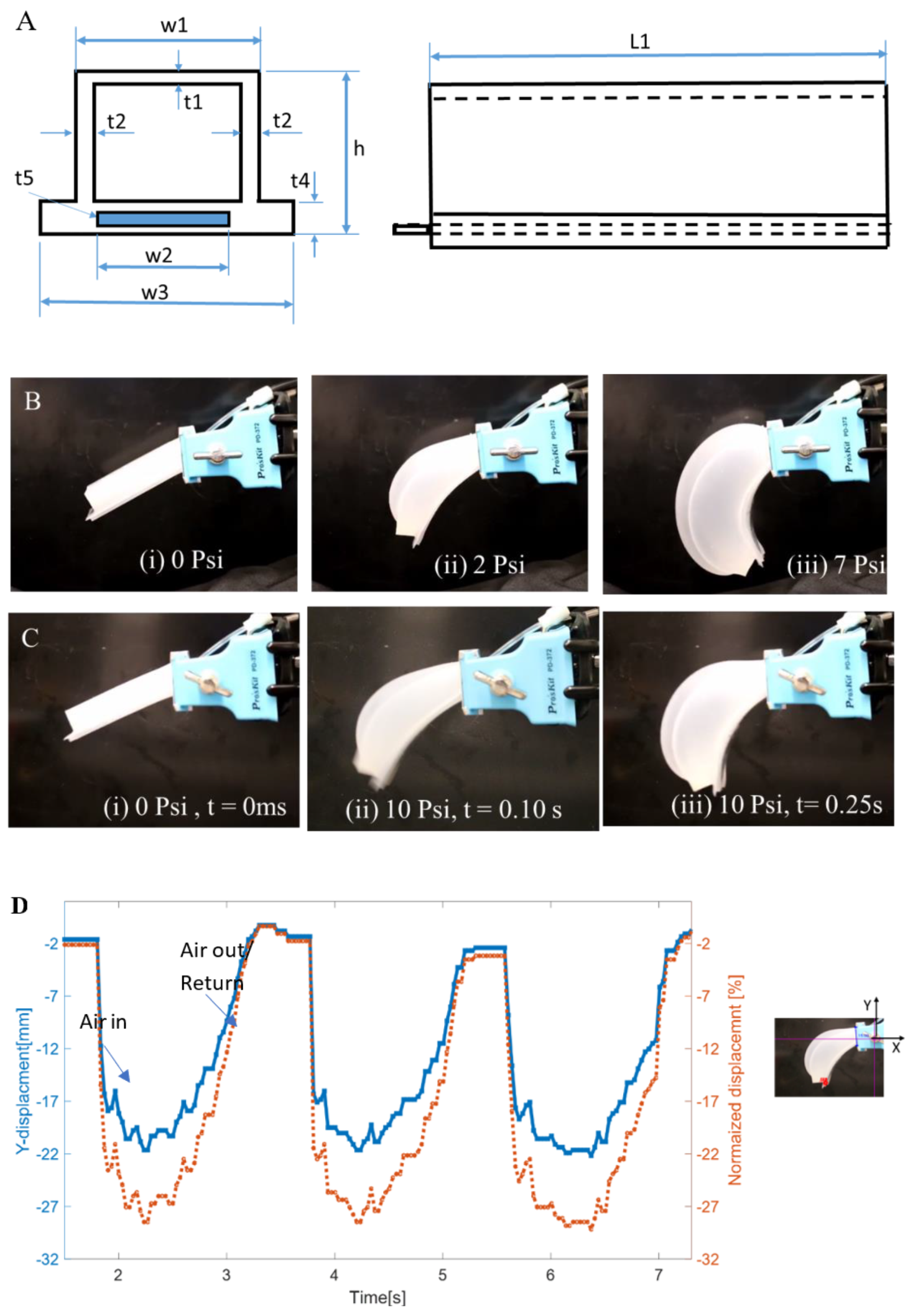
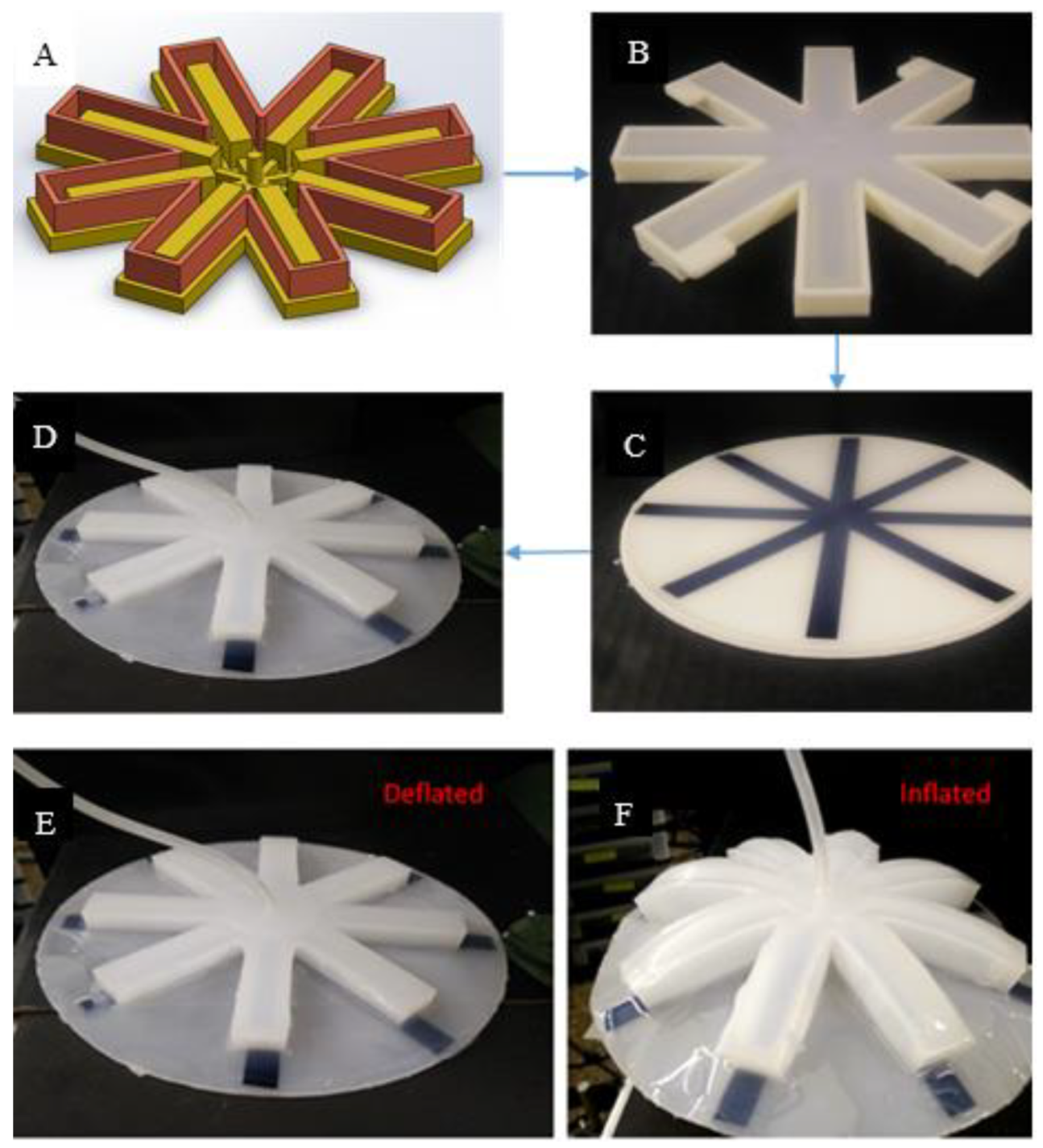
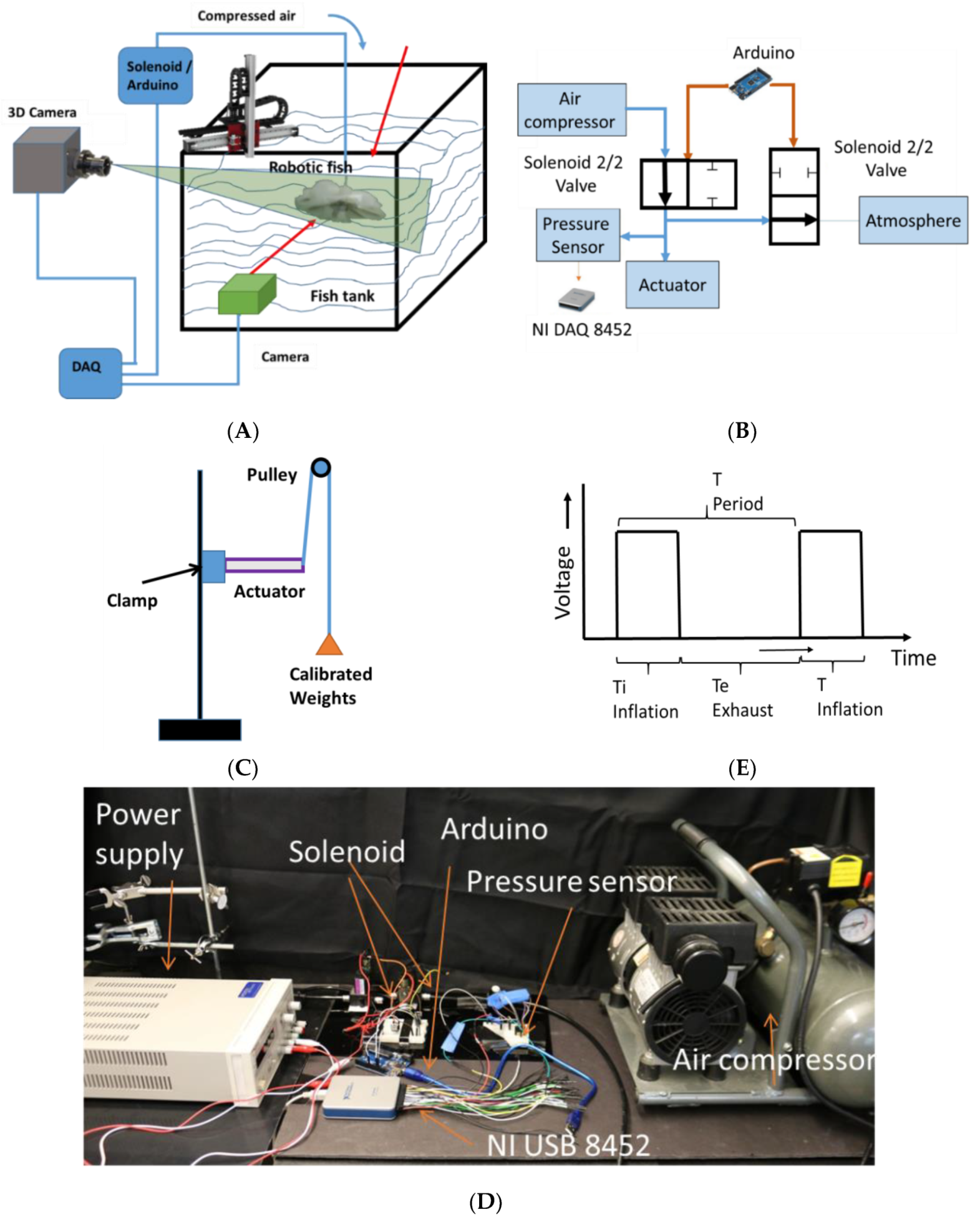
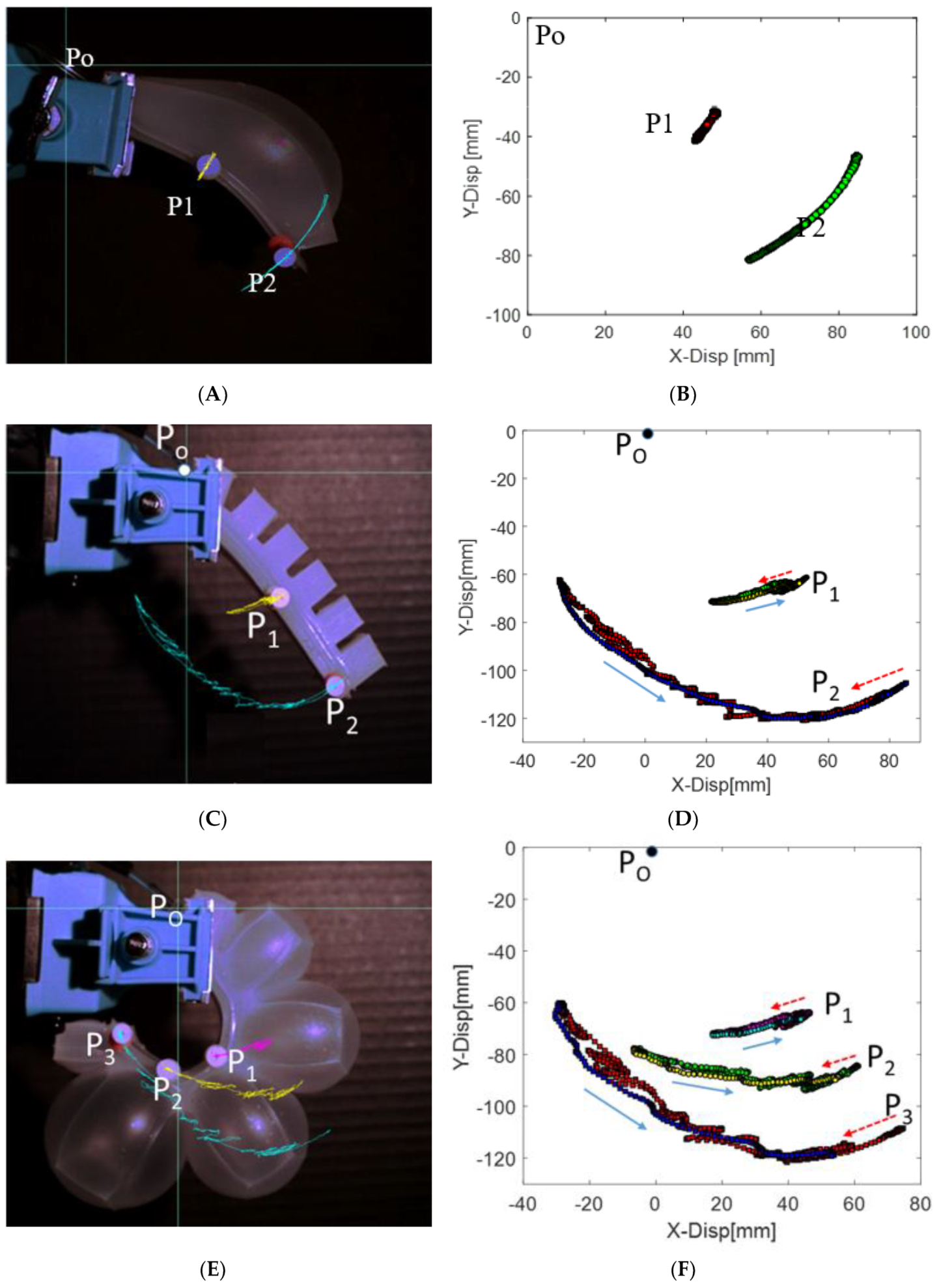
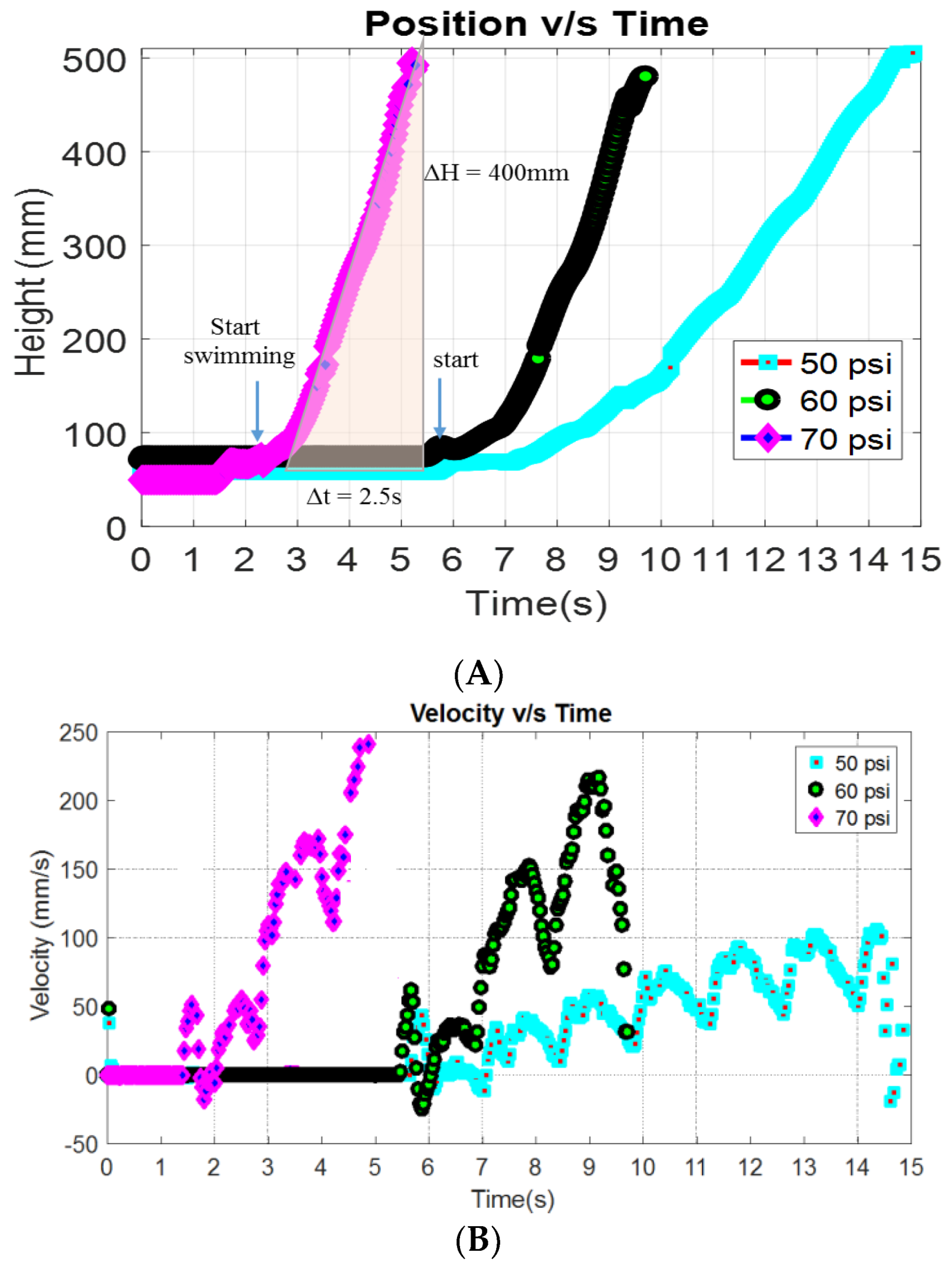


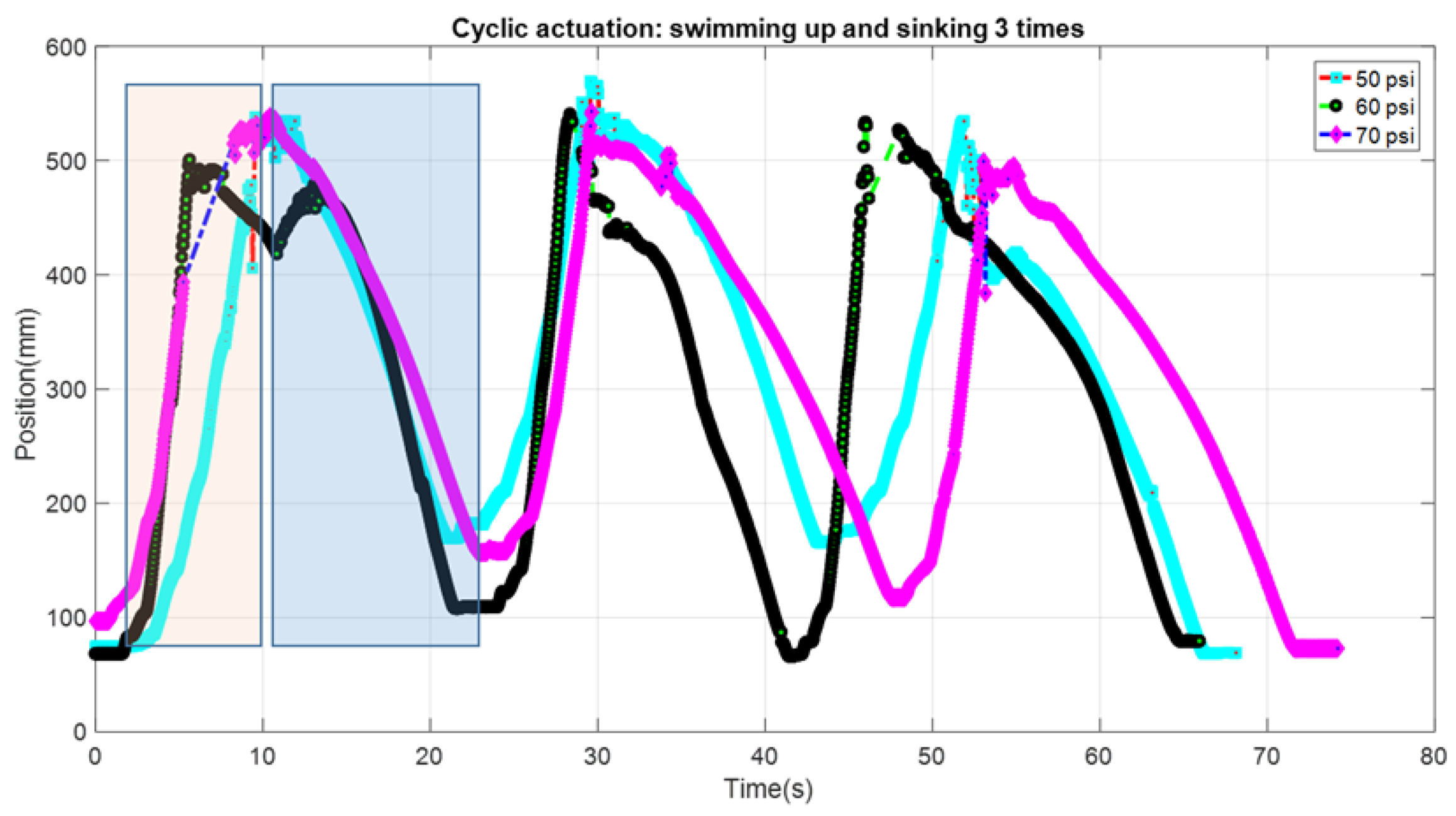





© 2019 by the authors. Licensee MDPI, Basel, Switzerland. This article is an open access article distributed under the terms and conditions of the Creative Commons Attribution (CC BY) license (http://creativecommons.org/licenses/by/4.0/).
Share and Cite
Joshi, A.; Kulkarni, A.; Tadesse, Y. FludoJelly: Experimental Study on Jellyfish-Like Soft Robot Enabled by Soft Pneumatic Composite (SPC). Robotics 2019, 8, 56. https://doi.org/10.3390/robotics8030056
Joshi A, Kulkarni A, Tadesse Y. FludoJelly: Experimental Study on Jellyfish-Like Soft Robot Enabled by Soft Pneumatic Composite (SPC). Robotics. 2019; 8(3):56. https://doi.org/10.3390/robotics8030056
Chicago/Turabian StyleJoshi, Aniket, Adwait Kulkarni, and Yonas Tadesse. 2019. "FludoJelly: Experimental Study on Jellyfish-Like Soft Robot Enabled by Soft Pneumatic Composite (SPC)" Robotics 8, no. 3: 56. https://doi.org/10.3390/robotics8030056
APA StyleJoshi, A., Kulkarni, A., & Tadesse, Y. (2019). FludoJelly: Experimental Study on Jellyfish-Like Soft Robot Enabled by Soft Pneumatic Composite (SPC). Robotics, 8(3), 56. https://doi.org/10.3390/robotics8030056





